Песни ВОВ
-
- 22 июня
- А годы уходят
- А туман на луга ложится
- Аджимушкай
- Азовская партизанская
- Александровский сад
- Алёша
- Баксанская
- Баллада о красках
- Баллада о ледовой трассе
- Баллада о матери
- Баллада о Матросове
- Баллада о моем солдате
- Баллада о надежде
- Баллада о солдате
- Баллада о солдатском сне
- Баллада о Тане Савичевой
- Баллада о фронтовом кинооператоре
- Белорусская партизанская
- Бомбардировщики
- Бывалый моряк
- Была судьба
- Вечер на рейде
- Где ж ты, мой сад
- Где же вы теперь, друзья-однополчане
- Где-то около Бреста
- Где-то под Бекетовкой
- Годы огневые
- Горячий снег
- Грозой овеянные сны
- Грустные ивы
- Давай, дружище, помечтаем
- Давай закурим
- Давно мы дома не были
- Далеко иль недалечко
- Далеко родные осины
- Два солдата
- Двадцать пятое августа
- Две подруги
- Девятая застава
- Девятое мая
- День Победы
- Держитесь, ветераны!
- Дни войны
- Довоенный вальс
- Дубрава
- Дунай-голубой
- До свиданья, города и хаты
- Дороги
- Ехал казак воевать
- Ехал я из Берлина
- Если б не было войны
- Если отец герой
- Жди меня
- Заветный камень
- Играй, мой баян
- Когда песню поешь
- Моя любимая
- Моя Москва
- На солнечной поляночке
- Огонек
- Ой, туманы мои, растуманы
- Песня о Днепре
- Пришла и к нам на фронт весна
- Священная война
- Синий платочек
- Смуглянка
- Темная ночь
Ноты музыки из русских фильмов
- Остров невезения
- Песня про зайцев
- Помоги мне
Ирония судьбы или с легким паром
- Со мною вот что происходит
- Я спросил у ясеня
- Никого не будет в доме
- По улице моей
- У зеркала
- Мне нравится, что вы больны не мной
Кавказская пленница
- Если б я был султан
- Песенка о медведях
Служебный роман
- Мелодия
- Моей душе покоя нет
- У природы нет плохой погоды
Гардемарины вперед
- Не вешать нос, гардемарины!
- Дороги любви
- Ланфрен-ланфра
- Разлука
- Песня о дружбе
- Баллада о Байстрюке
Жестокий романс
- А напоследок я скажу…
- Снегурочка
- Романс о романсе
12 стульев
- Вальс
- Кафешантан
- Краковяк
- Мадам Грицацуева в погоне за Остапом
- Марш тиражной комиссии
- Полосатая жизнь
- Птичка на ветвях его души
- Художники
- Эллочка-людоедка
Земля Санникова
- Все было
- Есть только миг
- Сюита
На Дерибасовской хорошая погода, на Брайтон Бич опять идут дожди
- Мой поезд уехал
- Хелло, Америка
Прочие
-
- Смуглянка из фильма «В бой идут одни старики»
- Темная ночь из фильма «Два бойца»
- Старый клен из фильма «Девчата»
- Александра из фильма «Москва слезам не верит»
- Позвони мне, позвони… из фильма «Карнавал»
- Мне нравится, что Вы больны не мной (Ирония судьбы)
- Город, которого нет (Бандитский Петербург)
- Не растравляй моей души! (Петербургские тайны)
General Information
| Work Title | Piano Sonata No.10 |
|---|---|
| Alternative. Title | |
| Name Translations | Piano Sonata No. 10; Klaviersonate Nr. 10; Sonata para piano n.º 10; Pianosonaatti nro 10; Sonate pour piano nº 10 de Beethoven; Sonata per pianoforte n. 10; ピアノソナタ第10番; Pianosonate nr. 10; X Sonata fortepianowa Beethovena; Соната для фортепиано № 10; Соната для фортепіано № 10; Sonata per a piano núm. 10 de Beethoven; Σονάτα για πιάνο No. 10; Piano Sonata No. 10 (Beethoven); 피아노 소나타 10번; 第10號鋼琴奏鳴曲 (貝多芬) |
| Name Aliases | Piano Sonata No. 10 in G Major, Op. 14, No. 2; Pianosonate nr. 10 (Beethoven); Sonata para piano n.º 10 en sol mayor, Op. 14 n.º 2 |
| Authorities | |
| Composer | Beethoven, Ludwig van |
| Opus/Catalogue NumberOp./Cat. No. | Op.14 No.2 |
| I-Catalogue NumberI-Cat. No. | ILB 171 |
| Key | G major |
| Movements/SectionsMov’ts/Sec’s | 3 movements:
|
| Year/Date of CompositionY/D of Comp. | 1798-99 |
| First Publication. | 1799 |
| Dedication | Baroness von Braun |
| Average DurationAvg. Duration | 15-16 minutes |
| Composer Time PeriodComp. Period | Classical |
| Piece Style | Classical |
| Instrumentation | piano |
| External Links | Wikipedia article |
Соната для фортепиано № 23, «Апассионата», 1807 год
Произведение Бетховен написал для своего друга, графа Брунсвика. Оно получилось необыкновенно драматическим. Это одна из самых грустных сонат автора. При жизни композитор никак не назвал свое творение. Название “Апассионата” было придумано гораздо позже.
Биографы маэстро пишут, что композитор находился в то время в очень тяжелом эмоциональном состоянии. У него были разочарования в любви. Также он открыто высказывал недовольство тем, что происходит вокруг. Это нашло отражение и в музыке. Соната пронизана грустью и ощущением неизбежности. Сам Людвиг считал это сочинение одним из самых лучших. Он очень любил его и, когда его спрашивали, о чем оно, он советовал прочитать “Бурю” Шекспира.
Музыка получилась возвышенной и динамичной. Некоторые критики считают, что она отражает борьбу со злом, победу над ним. Ленц говорил о Сонате № 23, как об извержении вулкана.
Русский романс
-
- Ах, зачем эта ночь
- Белой акации гроздья душистые
- В час роковой
- Вы просите песен, их нет у меня
- Выхожу один я на дорогу
- Газовая косынка
- Гори, гори, моя звезда
- Две гитары
- Дремлют плакучие ивы
- Калитка
- Не брани меня, родная
- Нет, не любил он
- Нет, нет не хочу!
- Не пробуждай воспоминаний
- Не растравляй моей души!
- Не уходи, побудь со мною
- Ночь светла
- О, жизнь моя, постой! Не уходи!
- Однозвучно гремит колокольчик
- Осенние листья
- Отговорила роща золотая
- Отцвели хризантемы
- Очи черные (1 вариант)
- Очи черные (вариант 2)
- Пожалей
- Прощай
- Романс о романсе
- Тройка мчится
- Что это сердце?
- Я ехала домой
- Я люблю Вас так безумно
- Я помню вальса звук прелестный
Симфония № 5, ор. 67, 1808 год
Это знаменитое произведение стало невероятно популярным уже в первый год его выпуска. В австрийской столице была проведена его презентация. Там Симфония №5 вызвала очень много эмоций. Ее назвали выдающейся. Эрнст Гофман, композитор посчитал ее одной из самых значимых.
У композиции интересная история. Первые наработки композитор сделал в 1804 году. Но ему пришлось отложить работу. Он одновременно писал несколько произведений, в том числе и сонату №6. Но в это же время у гения начались проблемы со здоровьем. Он терял слух. В стране происходили не самые лучшие изменения, связанные с оккупацией войсками Наполеона. Все это привело к тому, что над сонатой композитор трудился около 4 лет.
Ноты русской классической музыки
- «Щелкунчик» Увертюра
- «Щелкунчик» №1 сцена зажигания ёлки
- «Щелкунчик» №2 марш
- «Щелкунчик» №3 детский галоп и танец родителей
- «Щелкунчик» №4 сцена с танцами
- «Щелкунчик» №5 сцена и танец гросс-фатер
- «Щелкунчик» №6 сцена
- «Щелкунчик» №7 сцена
- «Щелкунчик» №8 сцена
- «Щелкунчик» №9 вальс снежных хлопьев
- «Щелкунчик» №10 сцена
- «Щелкунчик» №11 сцена
- «Щелкунчик» Дивертисмент №12 шоколад
- «Щелкунчик» Дивертисмент №12 кофе
- «Щелкунчик» Дивертисмент №12 чай
- «Щелкунчик» Дивертисмент №12 трепак
- «Щелкунчик» Дивертисмент №12 танец пастушков
- «Щелкунчик» Дивертисмент №12 мамаша Гигонь и паяцы
- «Щелкунчик» Вальс цветов №13
- «Щелкунчик» №14 Pas de deux
- «Щелкунчик» №15 Финальный вальс
- «Щелкунчик» №16 Финал
«Времена года» (фортепианный цикл)
- Январь
- Февраль
- Март
- Апрель
- Май
- Июнь
- Июль
- Август
- Сентябрь
- Октябрь
- Ноябрь
- Декабрь
- Лезгинка (А. Рубинштейн)
- Прелюдия op.3 №2 до-диез минор (С. Рахманинов)
- Прелюдия №5 op.34 (Шостакович)
Reception
From the 1810s Beethoven’s reputation went largely undisputed by contemporary critics, and most of his works received favourable initial reviews. For example, an anonymous reviewer in October 1822 described the Op. 110 sonata as «superb» and offered «repeated thanks to its creator». In 1824, an anonymous critic reviewing the Opp. 109–111 sonatas wrote in the Allgemeine musikalische Zeitung that contemporary opposition against Beethoven’s works «had only small, fleeting success». The critic then commented, «Scarcely had any of ‘s artistic productions entered into the world than their fame was forever established.»
Adolf Bernhard Marx, in his March 1824 review of the sonata, lauded Beethoven’s work and particularly praised the third movement’s fugue, adding that the fugue «must be studied along with the richest ones by Sebastian Bach and Händel.» In the 1860 edition of his biography of Beethoven, Anton Schindler wrote that the fugue «is not difficult to play but is full of charm and beauty.» Likewise, William Kinderman describes the fugue’s subject as a «sublime fugal idiom».
When writing about the sonata in 1909, Hermann Wetzel observed, «Not a single note is superfluous, and there is no passage … that can be treated as you please, no trivial ornament». Martin Cooper claimed in 1970 that Op. 110 was the most frequently played out of the last five Beethoven piano sonatas.
In the program notes for his 2020 online concert of the Opp. 109–111 sonatas, Jonathan Biss writes of Op. 110: «In none of the other 31 piano sonatas does Beethoven cover as much emotional territory: it goes from the absolute depths of despair to utter euphoria … it is unbelievably compact given its emotional richness, and its philosophical opening idea acts as the work’s thesis statement, permeating the work, and reaching its apotheosis in its final moments.»
Background, About the Composition
Ludwig van Beethoven (1770 – 1827) wrote the Piano Sonata No.31 in A♭ major, op.110, in 1821 — in terms of piano compositions, “only” the sonata op.111, the Diabelli Variations (op.120) and two sets of Bagatelles (op.119 and op.126) were to follow.
I. Moderato cantabile molto espressivo (3/4)
The first movement is annotated Moderato cantabile molto espressivo — formally, it is a sonata movement with exposition (39 bars), a development section (16 bars), a recapitulation (49 bars) and a Coda (12 bars), but it lacks a distinct (“classic”) first and second theme of 8, 16 or 32 bars: it rather works with “theme fragments”. The first theme fragment is just 4 bars and opens the movement, whereby the last bar leads over to the next theme, a very nice melody with semiquaver accompaniment:
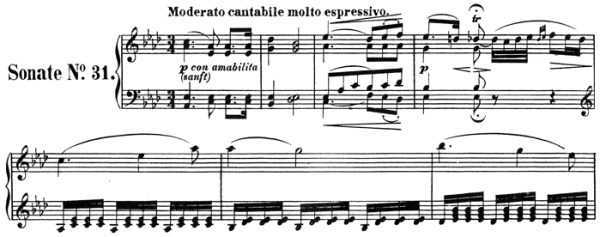
That melody just last 7 bars and is followed by an 8-bar demisemiquaver cascade, followed by “sort of” a second theme of 8 bars, which again is broken up into two 4-bar periods, where the second part can be seen as transition to a third theme of 10 bars. the development period primarily works with material from the initial 4 bars; the recapitulation is following anything but the classic idea of a harmonic variation of the exposition — it does roughly follow the exposition, but also freely combines / associates material from the various theme fragments. Overall, more of a fascinating fantasy than a rigid sonata movement.
II. Allegro molto (2/4)
The second movement has Scherzo character, in AABB – C – ABB-Coda form, whereby “A” is 8 bars, “B” is 32 bars; here’s the start of the movement with the “A” part and the first bares of “B”:
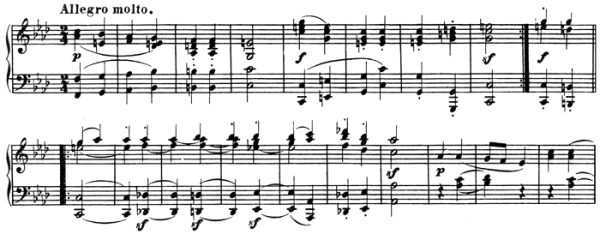
The “C” Part is mostly a sequence of 8-bar periods with quaver cascades ending in syncopated crotchet sforzati:
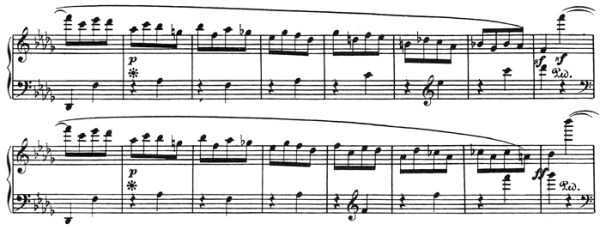
After the final repetition of the “B” part, the movement suddenly switches to a short, unexpected Coda that ends in a “ritardando question mark or colon”, supposed to open the expectation for the final movement, although there is no indication of an attacca:

The third and last movement is big and multi-faceted. One might think that the lead-out Coda in the preceding movement allows the composer to start the next movement in medias res — but not only is there no attacca indication, as mentioned, but that last movement starts with an introduction in B♭ minor, initially Adagio ma non troppo, but then interrupted with a recitativo bar (più adagio, ending in a brief Andante), followed by another Adagio, where a bar of more & more rapidly repeated notes (a” flat) in the right hand modulates to the dominant of E major, then leads into another recitativo bar (Meno adagio, then Adagio), which ends diminuendo smorzando, arriving in E♭ minor —
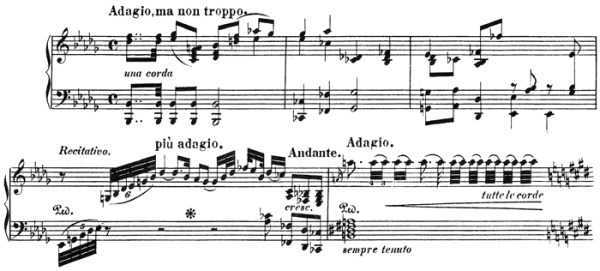
Fugue
And only after these 26 bars of a dramatic, expressive opening, we finally arrive at an impressive, three-part fuga in A♭ major (6/8), Allegro ma non troppo:

The fugue builds up into a stretta culmination, but then falls down into broken chords that lead into another Arioso (L’istesso tempo di Arioso), annotated Ermattend klagend, Perdendo le forze, dolente (losing forces, mourning), about the same length as the first Arioso, but this time in G minor, again 12/16:
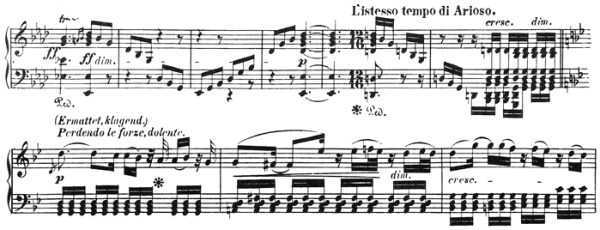
Towards the end, this Arioso loses all remaining forces, ending in a diminuendo, una corda — just to move into a miraculous transfiguration, with a set of chords, crescendo, implicitly written staccato, but with the sustain pedal kept down, modulating to G major:
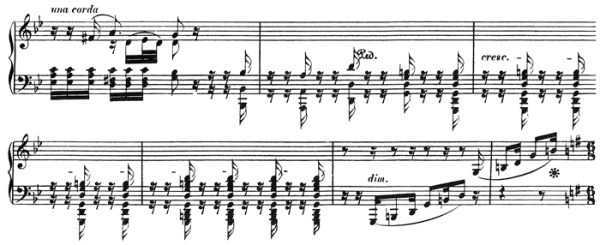
and then there’s another fugue, with the same theme as the first one, but inverted:

this fugue does not start firmly or forceful, but una corda and p, but slowly reviving. After an episode in G minor, the music definitely brightens up to A♭ major, building up from a Meno allegro section,

ending a glorious, jubilant, joyful, almost ecstatic, final culmination — truly per aspera ad astra!
Navigation etc.
| Beethoven Piano Sonatas | |
|
|
1 часть, Grave — Doppio movimento (b-moll)
Если в Траурном марше раскрыта общенародная трагедия, то содержанием сонатного allegro I части является личная драма, субъективное восприятие этой трагедии. Она начинается с краткого (4 такта) вступления–эпиграфа (Grave). Здесь возникает образ мрачного раздумья. Тема вступления строится на двух острохарактерных интонациях – ум.7, наделенной семантикой мучительного гамлетовского вопроса о смысле жизни, и нисходящей м.2, звучащей как горестный вздох, сожаление.
Сонатная экспозиция отличается предельно резкой контрастностью образов: полная драматизма реальность (главная и заключительная партии) сопоставляется с возвышенным идеалом (побочная).
Нервно-взвинченная главная тема (Doppio movimento) пронизана беспокойным смятением, вся она – в непрерывных мелодических взлетах и падениях. Это цепь коротких, отрывистых, взволнованно вопрошающих интонаций на возбужденно пульсирующем фоне сопровождения. Многочисленные короткие паузы создают сходство с частым, прерывистым дыханием. Форма темы (период из двух предложений по 16 тактов?) близка шопеновским прелюдиям: единое нарастание с кульминацией и завершением.
Быстрый переход к побочной партии (без связующей темы) подчеркивает остроту конфликта. В основе побочной темы – возвышенный хорал, жанр-символ, олицетворяющий отрешение от земных волнений. Тональность побочной – Des-dur – появится далее в трио Траурного марша, где воплощается сходный образ прекрасной, но недостижимой мечты.
Второе проведение побочной темы дано в новой – ноктюрновой фактуре. По мере продвижения к кульминации музыка приобретает порывисто-страстный характер.
Токкатная заключительная партия – еще один самостоятельный образ, насыщенный мужественной энергией, особенно в бурном натиске завершающего экспозицию stretto.
Экспозиция повторена, как в классических сонатных формах.
Несмотря на сравнительно небольшие масштабы, разработка I части достигает высших вершин драматического напряжения. Она начинается в далеком fis-moll: глухо (sotto voce) и мрачно, в новом – унисонном – изложении, в низком регистре звучат прерывистые интонации главной партии. Им отвечает окрашенный теперь в мягкие тона первый мотив вступления. Полна острого страдания нисходящая фраза (c-moll, т.17 разработки), звучащая на фоне главной партии. После ее повторения (f-moll, т.25) начинается сильнейшее нарастание динамики. Интонации главной партии, перемещенные теперь в верхний, «крикливый» регистр, становятся похожими на стоны и восклицания; в контрапункте с ней, в басу, развивается начальный мотив вступления.
После интенсивного развития главной партии в разработке Шопен уже не возвращается к ней в репризе: реприза начинается сразу с побочной партии в B-dur (такая реприза называется неполной).
Главная тема напоминает о себе лишь в краткой коде, которая по мрачно-тревожному колориту близка к разработке. Кода, несмотря на мажорную тональность, не вносит успокоения, не создает впечатления, что драма завершена, а заставляет ждать дальнейших событий.
Background
In the summer of 1819, Adolf Martin Schlesinger, from the Schlesinger firm of music publishers based in Berlin, sent his son Maurice to meet Beethoven to form business relations with the composer. The two met in Mödling, where Maurice left a favourable impression on the composer. After some negotiation by letter, the elder Schlesinger offered to purchase three piano sonatas for 90 ducats in April 1820, though Beethoven had originally asked for 120 ducats. In May 1820, Beethoven agreed, and he undertook to deliver the sonatas within three months. These three sonatas are the ones now known as Opp. , 110, and , the last of Beethoven’s piano sonatas.
The composer was prevented from completing the promised sonatas on schedule by several factors, including his work on the Missa solemnis (Op. 123), rheumatic attacks in the winter of 1820, and a bout of jaundice in the summer of 1821. Barry Cooper notes that Op. 110 «did not begin to take shape» until the latter half of 1821. Although Op. 109 was published by Schlesinger in November 1821, correspondence shows that Op. 110 was still not ready by the middle of December 1821. The sonata’s completed autograph score bears the date 25 December 1821, but Beethoven continued to revise the last movement and did not finish until early 1822. The copyist’s score was presumably delivered to Schlesinger around this time, since Beethoven received a payment of 30 ducats for the sonata in January 1822.
Adolf Schlesinger’s letters to Beethoven in July 1822 confirm that the sonata, along with Op. 111, was being engraved in Paris. The sonata was published simultaneously in Paris and Berlin that year, and it was announced in the Bibliographie de la France on 14 September. Some copies of the first edition reached Vienna as early as August, and the sonata was announced in the Wiener Zeitung that month. The sonata was published without a dedication, though there is evidence that Beethoven intended to dedicate Opp. 110 and 111 to Antonie Brentano. In February 1823, Beethoven sent a letter to the composer Ferdinand Ries in London, informing him that he had sent manuscripts of Opp. 110 and 111 so that Ries could arrange their publication in Britain. Beethoven noted that while Op. 110 was already available in London, the edition had mistakes that would be corrected in Ries’s edition. Ries persuaded Muzio Clementi to acquire the British rights to the two sonatas, and Clementi published them in London that year.
Ноты зарубежной популярной музыки
- Angelina
- Chances
- Church of your heart
- Cinnamon street
- Come back
- Cooper & Crash
- Dangerous
- Do you get
- Dressed for success
- Every time you leave
- Fingertips
- Here comes the weekend
- Hotblooded
- Joyride
- Keep me waiting
- Knockin on every door
- Listen To Your Heart
- Never is a long time
- Perfect day
- Queen of Rain
- Physical fascination
- Silver blue
- Small talk
- So far away
- Soul deep
- Spending my time
- Things will never be the same
- The big L
- The heart shaped sea
- The look
- The rain
- Watercolours in the rain
ABBA
- Happy New Year
- Money
- Thank You for The Music
- The Winner Takes It All
Evanescence
- All That Im Living For
- Away from me
- Bleed
- Breathe no more
- Bring Me To Life
- Call me when you’re sober
- Cartoon Network
- Cloud Nine
- Eternal
- Even In Death
- Everybodys fool
- Exodus
- Farther away
- Field Of Innocence Full Band
- Forgive Me
- Give unto me
- Going under
- Good enough
- Goodnight
- Hello
- Heart shaped box
- Imaginary
- Like You
- Listen to the rain
- Lithium
- Lost Control
- My immortal live
- My last breath
- October
- Sally’s Song
- So close
- Solitude
- Sweet Sacrifice
- Taking over me
- The last song I’m wasting on you
- Thoughtless
- Together again
- You
- Your Star
- Whisper
Linkin Park
- Bleed It Out
- Breaking The Habit
- Crawling
- Faint
- From the inside
- Given Up
- Hands Held High
- In Between
- In Pieces
- In the end
- Leave Out All The Rest
- Lying from you
- No More Sorrow
- Pushing Me Away
- Shadow of the Day
- The Little Things Give You Away
- Valentine’s Day
- What I’ve Done
- My December
Josh Groban
- Mi Morena
- Mi Mancherai
- Hymne A L’amour
- Caruso
- Broken Vow
- All ‘Improvviso Amore
- You’re Still You
- Lucia di lammermoor
- Home To Stay
- Let Me Fall
- My Confession
- Never Let Go
- Oceano
- Per Te
- Remember When It Rained
- She’s Out Of My Life
- Si Volvieras A Mi
- When You Say You Love Me
- You Raise Me Up
- Gira Con Me
30 seconds to Mars
- The Kill
- A Beautiful Lie
- A Modern Myth
- Alibi
- I’ll Attack
- Battle of one
- Buddha for Mary
- Edge of the Earth
- End of Beginning
- Hurricane
Beatles
- Across The Universe
- A Day In The Life
- A hard day’s night
- All you need is love
- And I love her
- Back In USSR
- Blackbird
- Can’t Buy My Love
- Day Tripper
- Eight days a week
- Eleanor rigby
- Every Little Thing
- From Me To You
- Get Back
- Getting better
- Good Day Sunshine
- Got To Get You Into My Life
- Here there and everywhere
- Hey jude
- I Want To Hold Your Hand
- If I Fell
- In My Life
- Lady Madonna
- Let it be
- Lucy In The Sky With Diamonds
- Maxwell’s silver hammer
- Michelle
- Norwegian Woods
- Ob-La-Di, Ob-La-Da
- Paperback Writer
- She’s Leaving Home
- She Loves You
- Something
- Ticket To Ride
- This Boy — Ringo’s Theme
- The fool on the hill
- The long and winding road
- We Can Work It Out
- When I’m Sixty Four
- With A Little Help From My Friends
- Yellow Submarine
- Yesterday
Lara Fabian
- Bambina
- Broken Vow
- Je Suis Malade
- Je T’aime
- La Lettre
- Si Tu M`aimes
- The Dream Within
Justin Bieber
- Eenie Meenie
- Lonely Girl
- Down To Earth
- Baby
- Never Let You Go
- One Time
- Where are you now
- You smile
Queen
- Another one bites the dust
- Bicycle race
- Bohemian rhapsody
- Calling all girls
- Crazy little thing called love
- Fat bottomed girls
- Flash
- Good old-fashioned lover boy
- I am in love with my car
- I want to break free
- It is a hard life
- It is late
- Keep yourself alive
- Killer queen
- Long away
- Need your loving tonight
- Play the game
- Radio ga ga
- Save me
- Somebody to love
- Tie your mother down
- Tear it up
- Under pressure
- We are the champions
- You are my best friend
Enya
- A Day Without Rain
- Flora’s Secret
- Only Time
- Tempus Vernum
- Wild Child
Joe D’Assin
- A Toi
- Billy Le Bordelais
- Ca Va Pas Changer Le Monde
- Dans Les Yeux D’Emilie
- La Bande A Bonnot
- Le Dernier Slow
- L’Amerique
- Et Si Tu N’existais Pas (1 вариант)
- Et si tu n`existait pas (2 вариант)
- Fais La Bise A Ta Maman
- IL Etait Une Fois Nous Deux
- La Fleur Aux Dents
- La Luzerne
- Le Chemin De Papa
- Les Champs-Elysees
- Les Dalton
- L’ete Indien
- Marie Jeanne
- Si Tu T’Appelles Melancolie
- Salut Les Amoureux
Yiruma
- …
- 27 May
- All Myself To You
- Chaconne
- Do You
- Dream
- Falling…
- I
- I’m just a…
- Indigo
- Kiss the rain
The Doors
- Break On Through
- Do It
- Hello, I love You
- I Looked At You
- Light My Fire
- My Eyes Have Seen You
- Riders On The Storm
- Tell All The People
- Wild Child
- You Make Me Real
Прочие
-
- All I want for christmas is you
- Nothing else matters (Metallica)
- Right here waiting for you (Richard Marx)
- L`Italiano (Тото Кутуньо)
- Song From A Secret Garden (дуэт Secret Garden)
- Sorry seems to be the hardest word (Элтон Джон)
- Don’t Worry Be Happy (Bobby McFerrin)
- Shape of my heart (Backstreet Boys)
- Ригодон
- Hijo de la luna (Mecano)
- Fairytale (А. Рыбак)
- Smells Like Teen Spirit
- Tears Of The Ocean
Ноты Новый год и Рождество
- A Holly Jolly Christmas
- All I want for christmas is you
- Angels We Have Heard On High
- Caroling Caroling
- Christmas Is
- Ding, dong! Merrilly on high
- Feliz Navidad
- Frosty The Snow Man
- Happy New Year (ABBA)
- Here Comes Santa Claus
- Home For The Holidays
- I Saw Mommy Kissing Santa Claus
- I’ll Be Home For Christmas
- It Came Upon The Midnight Clear
- Jingle Bells
- Jingle Bells (2 вариант)
- Let It Snow! Let It Snow! Let It Snow!
- O Holy Night
- O Little Town of Bethlehem
- Rocking Around The Christmas Tree
- Rudolph The Red-Nosed Raindeer
- Santa Baby
- Santa Claus Is Coming To Town
- Silent Night
- Silver Bells
- Snowfall
- This Christmas
- The Most Wonderful Day Of The Year
- You’re All I Want For Christmas
- We Wish You A Merry Christmas
- We wish you a Merry Christmas (2 вариант)
- А снег повалится, повалится
- Белая дорожка
- Белый снег
- В зимнем лесу
- В лесу родилась елочка
- Валенки
- Внучка Снегурочка
- Диалог у новогодней елки
- Динь-динь-динь
- Дед Мороз
- Добрая зима
- Елка
- Ёлочка
- Завирюха
- Зимний сад
- Зимняя любовь
- Зимняя школьная
- К нам приходит Новый Год
- Кабы не было зимы
- Карнавал у елки
- Маленькой ёлочке
- Метель
- Музыка под снегом
- Новогодняя полька
- Новогодняя хороводная
- Новогоднее пожелание
- Ой, ты, зимушка, зима
- Песенка деда мороза
- Песенка зайца и волка на карнавале
- Поет зима — аукает
- Снег кружится
- Снегурочка
- Снегурочка
- Снежинки
- Три белых коня
- Рождественская песня
- Снег идет
- Снег кружится
- Эх вы сани, сани…
Соната № 9 для скрипки и фортепиано, op. 47, «Крейцерова соната»
Название соната получила в честь Рудольфа Крейцера, которому Бетховен ее посвятил, однако по изначальной задумке она должна была называться иначе.
Первым исполнителем стал скрипач Джордж Бриджтауэр, сыгравший ее вместе с композитором в Вене 24 мая 1803 года.
Музыка вновь была написана в спешке, из-за чего часть нот имелась в единственном экземпляре, так что Бриджтауэру во время выступления приходилось заглядывать через плечо Бетховена, сидевшего за фортепиано.
Именно Джорджу немец посвятил сонату, но потом передумал. Почему? Точного ответа нет, но есть пара легенд.
Согласной одной, в ночь после премьеры скрипач оскорбил знакомую даму Бетховена, что стало причиной крупной ссоры между ними.
Другая версия гласит, что Крейцер просто был более известным в те годы. Самое забавное, что последний никогда не исполнял посвященное ему произведение, сочтя его крайне неудобным.
Navigation etc.
| Beethoven Piano Sonatas | |
|
|
Recordings
The Op. 110 sonata was recorded on 21 January 1932 by Artur Schnabel in Abbey Road Studios, London, for the first complete recording of the Beethoven piano sonatas. The piece was the first to be recorded in the set. Myra Hess’ recording of the work in 1953 was described by The New Grove Dictionary of Music and Musicians as among her «greatest successes in the recording studio». Op. 110 was included in Glenn Gould’s 1956 recording of the last three Beethoven sonatas, and its third movement was discussed and performed by Gould on a 4 March 1963 broadcast. As part of complete recordings of the Beethoven piano sonatas, Op. 110 was recorded by Wilhelm Kempff in 1951, Claudio Arrau in 1965, Alfred Brendel in 1973, Maurizio Pollini in 1975, Daniel Barenboim in 1984, and Igor Levit by 2019.
Ноты музыки из зарубежных фильмов
- Bop to the Top
- Breaking Free
- Get’cha Head in the Game
- I can`t take my eyes off of you
- Start of somethign new
- Stick to the status quo
- We`re all in this together
- What I`ve been looking for
- When there was me and you
Пираты Карибского моря – На краю Света
- At Wit’s End
- Brethren Court
- Drink Up Me Hearties
- Hoist The Colours
- I Don’t Think Now’s The Time
- I See Dead People In Boats
- One Day
- Singapore
- Up Is Down
Пираты Карибского моря — Сундук мертвеца
- Davy Jones plays his organ
- Davy Jones
- Dinner is served
- I’ve got my eye on you
- Jack Sparrow
- Kraken
- Two hornpipes
- Wheel of Fortune
The Phantom of the Opera (мюзикл)
- Angel of music
- Music of the night
- The Phantom of the Opera
Chicago (мюзикл)
- Nowadays
- All I care about
- All that jazz
- Class
- Funny honey
- Mister Cellophane
- Razzle Dazzle
- When you`re good to mama
Lord of the Rings Trilogy
- Twilight And Shadow
- The Steward Of Gondor
- Rohan
- The Return Of The King
- The Prophecy
- Minas Tirith
- Many Meetings
- May It Be
- Lament for Gandalf
- Isengard unleashed
- In Dreams
- Gollum’s song
- Forth Eorlingas
- Evenstar
- Breath of Life
- Aniron
Прочие
-
- Тема из кинофильма X-files
- Симпсоны
- Розовая пантера (The Pink Panther)
- История любви (Love Story)
- My Heart Will Go On (Titanik)
- Тема любви (Ромео и Джульетта)
- The Meadow (Сумерки)































